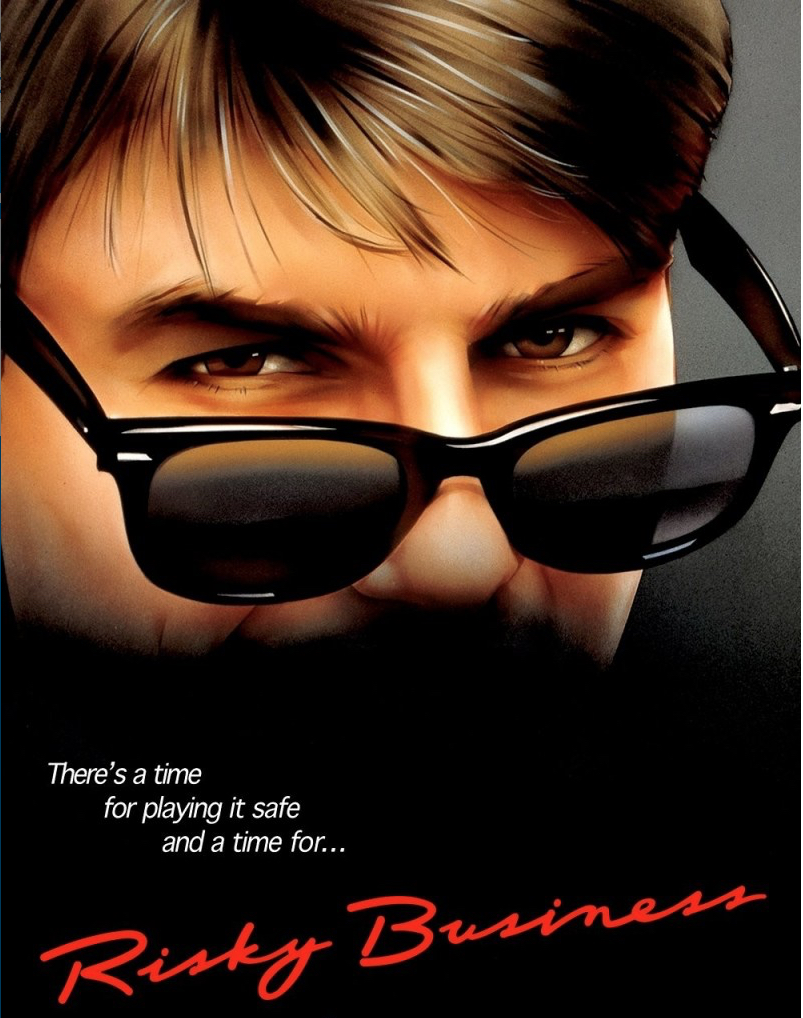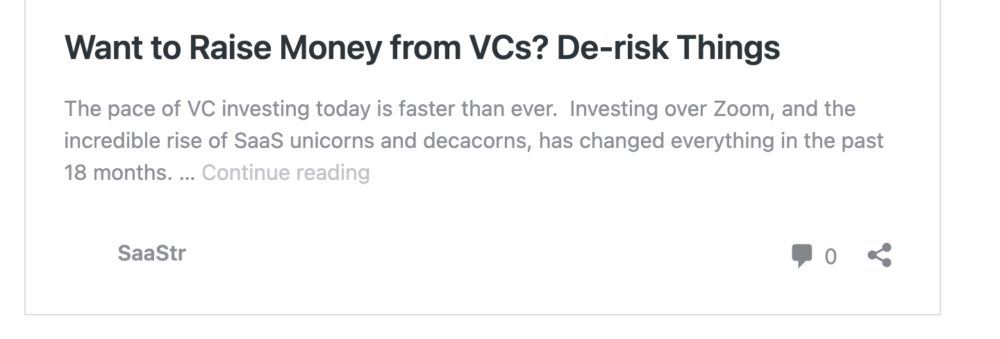It's not just FTX
Every VC I catch up with has a quiet story of fraud in their portfolio
Numbers that were sort of made up usually
Most won't ever be discussed or end up public
— Jason
Be Kind
Lemkin (@jasonlk) November 10, 2022
I’ve had the privilege to invest one way or another in about 35 SaaS companies, both as a VC and as angel. 6 have become decacorns and unicorns, and 3 have sold for $1B+ cash. It’s a pretty solid group and I’ve learned a lot from it.
One experience that confuses a lot of founders is when it really starts to take off — I mean, when it’s really now clearly good — and they still get “No”s from VCs. They understand why they got “No”s in the early, pre-traction days, and even, in the early-ish days when they had a handful of customers but wasn’t really taking off yet (my favorite time to invest).
But then, once they get to say $1m+ ARR, growing 15%, 16, 20% a month — why isn’t every VC they meet offering a term sheet? Especially when some other crappy company just got funded last week with worse metrics. Or their friends got 7 term sheets with good-but-not-as-good companies.
The answer usually is pretty simple — Early Stage VCs take different types of risks. Later, once you past $20m ARR, and later — if your growth is strong, everyone probably wants to invest. The main issue is price. But at any stage before that, it turns out, different VCs specialize in the types of risks they like to take … and the types they don’t.
Let me make a list, of at least 10 Risks Different SaaS VCs Do and Do Not Like To Take. And the key is, it really varies from VC to VC. And in the Boom Times of 2021 and such, VCs took a lot more risk across the board. But now they are back to picking the types of risk they like to take:
- Lack of A+ Engineering Team Risk. In SaaS, VCs seem to split two ways on the engineering team. Some want a world-class, proven, sizeable team with perfect pedigrees. The Googlers. The Palantirians. They want that. They see it as a key differentiator to win as you scale. Which it certainly can be. Others … really don’t care. They see every SaaS product starting as a hack, no matter who builds it. And they view a young, even first-time team as either a competitive advantage as well, or at least, not a huge disadvantage. In any event, VCs that consistently back “world class” engineering teams generally don’t like SaaS companies without them, no matter how successful they are.
- Too Many Tech and/or Insider-ish Customers Risk. Many VCs don’t count other YC companies as totally bonafide customers. Or they don’t like it if all your customers are in SOMA. They want to see “real” customers. Others don’t care as much. They know they getting anyone to buy Yet Another SaaS product means something. But if 50% of your customers are other YC companies, just bear in mind some VCs will turn you down. Others will still give you credit, at least partial credit.
- B+/A- Traction Risk. This one will frustrate you. Many Unicorn hunters want to see you go from $1m to $10m in 5 quarters or less. So if you hit $1m and you are “only” growing, say 8% a month, or even 10% a month … they may pass right there. Other VCs believe capital can accelerate growth. (I don’t, but many do). Growing too slowly after Initial Traction at a minimum means a lot of VCs will rule you out at any price.
- Lack of a (at least the Genesis of a) Management Team. You never have a perfect management team until you are at $10m+ ARR, at the earliest, in 98/100 cases. Still, some VCs want to see at least one solid VP on the team, or at least, one solid manager you can scale under. Some VCs will pay up even for very little growth and revenue so long as the management team is strong. They believe a strong team can literally will revenue into existence as long as there is the most basic product-market fit. And there is a lot of truth to this.
- Pilots-Don’t-Count Risk. I know you are proud Facebook is a customer. But if it’s a 10-seat pilot for 60 days, many VCs won’t give you any credit. At a broader level, if too many of your logos and proof points aren’t yet established customers — some VCs will walk. Others will assume you’ll convert them. I personally hate pilots, but will give you lots of credit for a closed, quality customer on a 1+ year contract … even if it just closed last week.
- Not enough U.S.-and/or Bay Area-ification. VCs just vary here, and it’s changed since 2020 a lot. Many though still want at least the CEO firmly established in the U.S. and even the SF Bay Area before they invest. Others want more than just the CEO here to see they can scale in the Bay Area / the U.S. It just varies. I’m 100% OK taking a lot of risk here because I know I can help them recruit a local team as much as necessary or desired. Others still don’t like this risk, however.
- We-Lost-Money-On-This-Before Risk. I hate this one, but it’s pretty common. “We did something like this a few years back and it didn’t scale.” Yes, but … Often that was so long ago, a different world, and a different product in a changed market. Still, it’s pretty common. If a VC lost money on something vaguely similar, or more importantly, just didn’t make a lot of money on something in vaguely the same space … they often will pass right there. Not Big Enough, they’ll pattern match and assume.
- Burn rate risk. Many VCs, especially ones with smaller (i.e., < $400m or so) funds get nervous around high burn rate start-ups. But in Billion Dollar funds, up to a point … they worry somewhat less. Billion+ funds often want to deploy a ton of capital to win a space quickly. And will tolerate a higher burn (within limits) to get there. They have the cash to invest, after all. And conversely, Billion+ VC funds may be less interested in start-ups they perceive as not willing to deploy a lot of capital to win. Today, though, everyone is concerned here. The round really has to last. The exact tolerance here really varies. Personally, I’ve learned even a slightly high burn rate often spirals out of control, so I try to avoid these investments.
- Lack of network effects / marketplace dominance risk. A lot of VCs are looking for structural reasons you can win and dominate your category. Network effects in your product, a marketplace element, or at least some tech/product/non-sales driven reason your app automatically gets more and more dominant as it scales. The reality is though most business process SaaS apps become dominant simply because they are the biggest. Which is expensive, can take tons of sales reps, and isn’t done through the software / network effects per se. Some VCs get this and just want to back the potential winner in a category. But others want a technology reason as well that you will dominate. What’s your moat?
- Not hot enough space (yet) risk. This is an issue for a lot of investors. I’d say at least 50% of SaaS VCs will pass if you aren’t in a Hot Space. You need to fit into Big Data, into Machine Learning, AI, or B2D tools, or whatever. Whatever the theme of the year is. This isn’t totally irrational. Hot companies do sort of need to ultimately be in a hot space to raise more capital at a higher price from the next guy. And thus they also command higher multiples, not just from VCs — but also from acquirers. Google or Salesforce or Amazon or whomever might pay $200m for a $2m ARR hot up in a super hot space they just need to acquire, but only $20m for a company with the exact same metrics in a boring space. And $20B for a Figma. It’s just a fact. At a minimum, expect a material valuation hit if you aren’t in a hot space.
So these are a lot of types of risks. Different SaaS VCs have different boxes, different parameters for the investments they like to make. You can’t really change that or even influence it much. Ask around, ask other founders, and look at the investments they’ve made and when they’ve made them. The reality is you’ve probably pitched VCs you never should really have even bothered meeting.
And until you’ve eliminated all 10 of the risks above … don’t take it personally if they pass. Each Early Stage VC checks makes different trade-offs among the 10 risks above as “must have” vs. “willing to take this risk.”
And a related post here:
(note: an updated SaaStr Classic post)
The post The Different Flavors of Risk Early Stage VCs Take appeared first on SaaStr.
via https://www.aiupnow.com
Jason Lemkin, Khareem Sudlow




